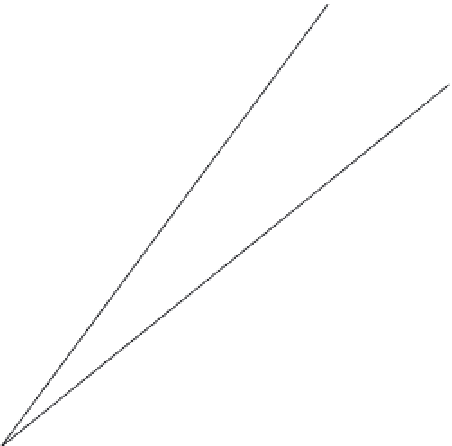Geology Reference
In-Depth Information
25
20
15
10
Fig. 4.6
Expected prediction and
uncertainty intervals vs. the predicted
value from the RHEM model. Expected
values were computed as the mean
of 1000 model runs, providing
randomly generated values for each
model parameter to compare with
predicted soil loss from three sample
storms at three separate locations
(after Wei
et al
., 2008).
5
Expected value
Lower uncertainty interval
Upper uncertainty interval
0
0
5
10
15
20
25
Predicted soil loss (kg/m
2
)
Section 4.5 has reviewed a wide range of ways
in which model developers have attempted to
describe model sensitivity, and the error or
uncertainty associated with erosion model pre-
dictions. All of these approaches demonstrate
some merit, although none can be described as a
holistic treatment of model uncertainty by quan-
tifying both input uncertainty (through parame-
terization and parameter interactions) and model
structural uncertainty: the dominant sources of
epistemic uncertainty discussed in Section 4.4.
In addition, few models have been adequately
evaluated against observed data, to demonstrate
how well predictions relate to real-world obser-
vations or to show how well observations are
captured within uncertainty bounds. The fol-
lowing section summarizes an attempt to deal
with these problems by using the GLUE approach
to evaluate the WEPP model against data from
both the UK and the US (Brazier
et al
., 2000).
Although it is by no means a complete assess-
ment of model uncertainty, it serves as a good
example of what can be done to assess the qual-
ity of model predictions, and to understand the
sources of model uncertainty which may help
model developers to constrain uncertainty in
future model development.
4.6
Case Study: Using WEPP to Predict
UK and US Erosion Data
Many papers have been written describing the
WEPP model and its applications (more than 100
to date), yet very few (as reviewed above) have
attempted to evaluate the uncertainty associated
with model predictions. If process-based soil ero-
sion models proliferate, in the same manner as
their forebears, the USLE family of models, and
this proliferation is not accompanied by assess-
ment of predictive uncertainty, then the field of
erosion modelling will not move forward in terms
of reducing this predictive uncertainty - a sce-
nario that is undesirable for both model develop-
ers and model users alike.
The WEPP model was analysed by Brazier
et al
. (2000) against data that were collected in
large plot-scale experiments in both the UK, at
the Woburn Erosion Reference Experiment (Catt
et al
., 1994), and the US, at the Holly Springs

























































































































